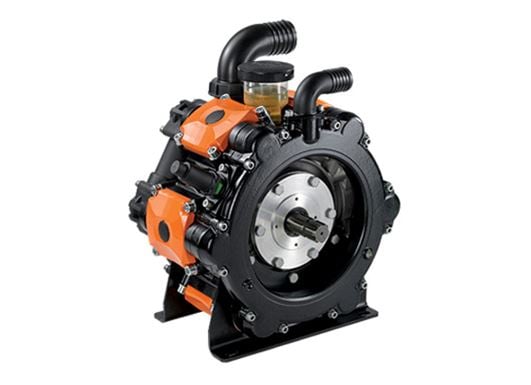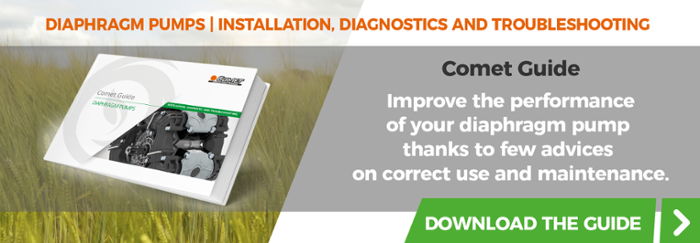Diaphragm pumps are used in a variety of fields every day but, although their uses turn out to be wide and frequent, not everyone is thoroughly familiar with their details and characteristics
Therefore, we have issued an article to answer the ten questions that are asked most about diaphragm pumps.
HOW DO DIAPHRAGM PUMPS WORK?
A diaphragm pump is a positive displacement pump that contains a diaphragm capable of moving in a reciprocating manner, thus creating a compression chamber that draws in and expels fluid through the pump itself.
In addition, the diaphragm serves as a separation wall between the air and the pumped fluid, thus offering the possibility of handling liquids with various levels of viscosity and corrosive and very aggressive chemicals without damaging the pump components.
READ: DIAPHRAGM PUMPS, WHAT THEY ARE AND HOW THEY WORK

DO DIAPHRAGM PUMPS HAVE A MOTOR?
Diaphragm pumps consist of two basic parts: the transmission and the pumping unit. This type of pump converts the mechanical energy of a motor - either electric, internal combustion or hydraulic - into the dynamic pressure of the fluid being pumped.
The transmission, then, transfers energy from the motor to the pump, while the pumping unit converts mechanical energy into pressure.
It is the rotational shaft of the transmission that receives the energy from the motor and transforms the rotary motion into oscillatory motion through a connecting rod-crank system connecting the shaft to the piston. This transmission system is very similar to that of a two-stroke internal combustion engine, but in this case the energy, instead of from the piston to the shaft, is transmitted from the shaft to the piston and the diaphragm.
READ: THE COMPONENTS OF THE DIAPHRAGM PUMPS

HOW TO SIZE A DIAPHRAGM PUMP?
Proper sizing of a diaphragm pump is critical to achieving effective results. While, therefore, the versatility of these tools allows them to be used with a wide range of fluids, it is necessary to be able to identify a certain number of parameters in order to choose the most suitable and appropriately-sized pump:
- the type of fluid to be handled;
- the flow rate required;
- the delivery pressure;
- the suction priming and head;
- the temperature range of the fluid.
After having identified these parameters, it will then be necessary to make a choice between air-compressed pumps, mechanically driven pumps and electric pumps: this choice depends on the kind of the fluid, the pressure required and, most importantly, the availability of power sources to operate the pump.
It is equally important to evaluate the material of the pump and of the diaphragm. There are several materials available for making the diaphragms (rubber, thermoplastic, PTFE, etc.): the choice should fall on the material best suited to resist corrosiveness or abrasiveness of the pumped fluid. The same applies to the materials used for other pump components, which must be compatible with the fluid and the environmental conditions of the work to be done.
READ: THE MAIN PARAMETERS DEFINING THE PERFORMANCE OF A PUMP
TO WHAT EXTENT CAN A DIAPHRAGM PUMP PUMP?
Diaphragm pumps can develop quite high discharge pressures. For example, they are often used in filter press applications and, if properly modified, can reach as high as 200 Psi.
They can also reach high discharge heads and are capable of priming liquids up to 70 meters by height; therefore, they are often used for transferring liquids from underground wells or also used completely submerged in the liquid to be pumped, as long as they are connected to an outlet allowing the pump to expel air.
In the self-priming mode, however, a diaphragm pump can be installed above the fluid being transferred with a suction height of up to 8 meters from a wet hose and 5 meters if the suction hose is empty (the suction capacity will depend on the size of the pump).
HOW MUCH SUCTION POWER DOES A DIAPHRAGM PUMP HAVE?
Air-operated diaphragm pumps, in most cases, can handle pressures up to 125 psi or 8.6 bar.
However, to prevent the pump from exceeding these parameters and causing failure, the pressure should be monitored by installing an air regulator on the inlet route, while also being able to control the flow rate.
In fact, if the allowable pressure limit is exceeded, the pump may run into various kinds of problems:
- the valve ball closest to the intake will be pushed out of its seat;
- if the pump is started at the limit of its pressure range it will not yet be filled with liquid, so the valve seat will not close properly and the necessary vacuum will not be created;
- constant use at high pressure can cause permanent damage to the diaphragm and other internal components.
A special topic can be made for agricultural pumps. Widely used for spraying, weed control and treatment of orchards, vineyards and olive groves, the diaphragm pumps for agriculture are divided into:
- low-pressure pumps (up to 20 bar): intended for application on boom sprayersfor the treatment of field crops such as cereals, tomatoes and vegetables;
- high-pressure pumps (between 30 and 50 bar): these are used on orchard sprayersfor the treatment of vineyards, orchards and olive groves.
ARE DIAPHRAGM PUMPS EFFICIENT?
We have already talked about the versatility of diaphragm pumps; these are also very easy to use and require little maintenance. Let’s see, now, the main reasons why they turn out to be very efficient tools.
Let’s start with their excellent priming and self-priming capacity resulting from the ability to create a good vacuum on the suction line. In fact, a diaphragm pump can prime fluids from levels below the one it is in, being able to draw liquids from channels or basins below it, greatly benefiting the loading stages of a tank.
In addition, these pumps do not need to fill the suction hose to be activated (like centrifugal pumps), due to the ability to suck in the air contained in the suction hose during start-up and remove it through the delivery line (self-priming).
In addition, due to the lubricated drive mechanism, diaphragm pumps can withstand reasonable periods of dry running without adverse consequences in self-priming mode or in case of suction line failure.
Finally, because it has no direct contact with the liquid, the diaphragm pump is the only one that can pump liquids that are not perfectly filtered with solid particle residues.
READ: 3 MAJOR ADVANTAGES OF USING A DIAPHRAGM PUMP AS AN AGRICULTURAL PUMP
WHICH FLUIDS ARE DIAPHRAGM PUMPS BEST SUITED FOR?
Due to the wide range of materials used to produce them, diaphragm pumps are suitable for use with various fluids to be pumped, even those that are difficult to deal with such as:
- corrosive chemicals;
- volatile solvents;
- viscous and sticky fluids;
- cut-sensitive food and pharmaceutical products;
- dirty water and abrasive sludge;
- small solid particles;
- creams, gels and oils.

IN WHAT FIELDS ARE DIAPHRAGM PUMPS MOST SUITABLE?
Having already made it abundantly clear what kind of use they have in agriculture, we must say that diaphragm pumps are nevertheless used in many professional fields. In general, they are used for the fluid transfer and low-pressure spraying applications that require smooth and steady flow.
For these reasons, diaphragm pumps are used in the following professional fields and related uses:
- automotive: paint transfer and waste disposal;
- ceramics: sewage and wastewater transfer;
- chemical processing: material and acid transfer and chemical pumping;
- food and beverage: food and beverage processing and ingredient transfer;
- printing, packaging, pulp and paper: transfer of inks, glues, solvents and adhesives;
- water treatment: water treatment and transfer and wastewater management;
- paint production: mixing, loading, unloading and transferring acrylics, solvents, resins, pigments and additives.
DO DIAPHRAGM PUMPS HAVE PROBLEMS?
A diaphragm pump works optimally when properly installed and carefully maintained. Sometimes, however, it may still have problems with pressure, priming, noise, abnormal pulsation and excessive oil consumption.
We become aware of pump problems, most of the time, when we notice liquid leaks; this inconvenience can depend on several factors: loose housings, piping problems, broken or damaged diaphragm, blocked valves, etc.
Below you can find a special article devoted to the maintenance required to ensure optimal efficiency of the diaphragm pump.
READ: MAINTENANCE OF A DIAPHRAGM PUMP: WHAT TO DO TO AVOID PROBLEMS
DO DIAPHRAGM PUMPS NEED LUBRICATION?
For the smooth operation of a diaphragm pump, a proper lubrication is essential.
Moving parts such as diaphragm and valve stems should be lubricated periodically, following the pump manufacturer’s instructions.
In fact, lubricating regularly reduces the friction between parts and their wear and tear, and extends the overall life cycle of the pump.
READ: MAINTENANCE OF A DIAPHRAGM PUMP: THE RIGHT OIL EXTENDS ITS LIFE
DISCOVER COMET’S RANGE OF DIAPHRAGM PUMPS FOR AGRICULTURE














